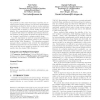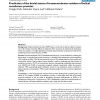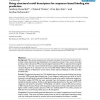258 search results - page 18 / 52 » A Framework for Improving Protein Structure Predictions by T... |
BMCBI
2008
13 years 8 months ago
2008
Background: Prediction of disulfide bridges from protein sequences is useful for characterizing structural and functional properties of proteins. Several methods based on differen...
CIKM
2009
Springer
14 years 3 months ago
2009
Springer
Background: Although both conservation and correlated mutation (CM) are important information reflecting the different sorts of context in multiple sequence alignment, most of ali...
GECCO
2005
Springer
14 years 2 months ago
2005
Springer
The prediction of the native structures of proteins, the socalled protein folding problem, is a NP hard multi-minima optimization problem for which to date no routine solutions ex...
BMCBI
2007
13 years 8 months ago
2007
Background: Helical membrane proteins (HMPs) play a crucial role in diverse cellular processes, yet it still remains extremely difficult to determine their structures by experimen...
BMCBI
2007
13 years 8 months ago
2007
Background: Many protein sequences are still poorly annotated. Functional characterization of a protein is often improved by the identification of its interaction partners. Here, ...



